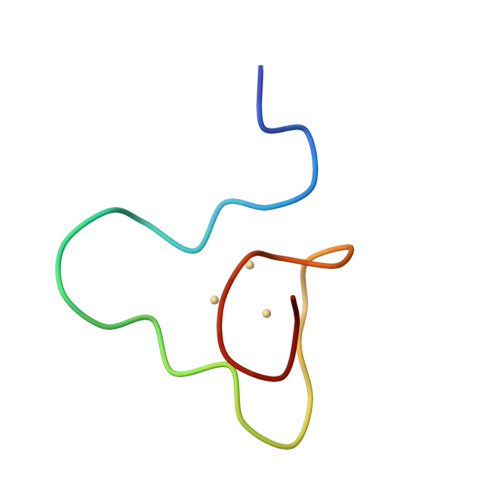Three-dimensional solution structure of mouse [Cd7]-metallothionein-1 by homonuclear and heteronuclear NMR spectroscopy.
Zangger, K., Oz, G., Otvos, J.D., Armitage, I.M.(1999) Protein Sci 8: 2630-2638
- PubMed: 10631978
- DOI: https://doi.org/10.1110/ps.8.12.2630
- Primary Citation of Related Structures:
1DFS, 1DFT - PubMed Abstract:
Sequential 1H-NMR assignments of mouse [Cd7]-metallothionein-1 (MT1) have been carried out by standard homonuclear NMR methods and the use of an accordion-heteronuclear multiple quantum correlation (HMQC) experiment for establishing the metal, 113Cd2+, to cysteine connectivities. The three-dimensional structure was then calculated using the distance constraints from two-dimensional nuclear Overhauser effect (NOE) spectroscopy spectra and the Cys-Cd connectivities as input for a distance geometry-dynamical simulated annealing protocol in X-PLOR 3.851. Similar to the mammalian MT2 isoforms, the homologous primary structure of MT1 suggested two separate domains, each containing one metal cluster. Because there were no interdomain constraints, the structure calculation for the N-terminal beta- and the C-terminal alpha-domain were carried out separately. The structures are based on 409 NMR constraints, consisting of 381 NOEs and 28 cysteine-metal connectivities. The only elements of regular secondary structure found were two short stretches of 3(10) helices along with some half-turns in the alpha-domain. Structural comparison with rat liver MT2 showed high similarity, with the beta-domain structure in mouse MT1 showing evidence of increased flexibility compared to the same domain in MT2. The latter was reflected by the presence of fewer interresidue NOEs, no slowly exchanging backbone amide protons, and enhanced cadmium-cadmium exchange rates found in the beta-domain of MT1.
Organizational Affiliation:
Department of Biochemistry, Molecular Biology and Biophysics, University of Minnesota, Minneapolis 55455, USA.

















